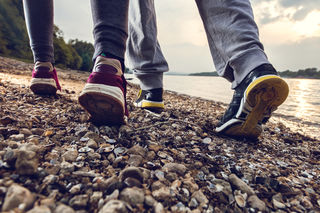Happiness
Can "Blue Space" Provide Therapeutic Benefits?
Research suggests that a shoreline walk may offer an extra dose of happiness.
Posted March 22, 2019

Travel ads are filled with images of beckoning beaches for a reason. It's difficult to resist a beautiful water view, and that allure hasn’t been lost on psychological and environmental researchers. Thanks to a spate of recent studies, there’s growing evidence that being around "blue space"—natural aquatic features such as lakes, rivers, and coastal waters—can be good for our mental health.
That may explain why so many of us feel drawn to the water when it’s time for rest and relaxation. In England alone, one survey found that people make a whopping 271 million recreational visits to coastlines and beaches each year. And the most popular activity during these visits isn’t sunbathing, swimming, or fishing. It’s walking along the shore.
Happier, Out of the Blue
Psychological and environmental researchers around the globe have become increasingly intrigued by our psychological response to blue space. Here’s a sampling of what they’ve found:
- A 2018 study from Hong Kong showed that people who regularly visited blue spaces in their free time reported greater well-being, compared to those who didn’t make such visits. They also had a lower risk of depression. Likewise, another recent study, this one from Ireland, found that better views of the sea were associated with lower depression scores in older adults.
- A review of 35 earlier studies, led by researchers at the Barcelona Institute for Global Health, showed that interacting with blue spaces had a positive impact on mental health and stress reduction. Being around blue space was also linked to greater physical activity—and that, in itself, can help further enhance well-being and reduce the risk for depression.
- Some studies have focused on how participating in outdoor aquatic activities (such as fly-fishing, kayaking, and surfing) may help people with specific health challenges (such as post-traumatic stress disorder, drug and alcohol addiction, and breast cancer). Overall, the studies suggested that many participants benefited both psychologically and socially.
The latter group of studies didn’t specifically address walking by the water. But other research suggests that social connectedness, such as you might feel when strolling side-by-side with someone, adds to the potential for reducing anxiety and depression while raising self-esteem.
Soaking Up the Serenity
Of course, you don’t have to wait for a vacation to enjoy walking along the shore of an ocean, lake, or river. Many people naturally gravitate toward the nearest blue space for their regular walks.
“I make it a point to go on a beach walk with my husband and our two dogs at least twice a week,” says Christine Scott-Hudson, M.A., LMFT, ATR, a psychotherapist and art therapist in Santa Barbara, California. “Going on a beach walk has restorative powers that exercising inside of a gym just does not have. Looking out onto the blue water is both relaxing and healing.”
It’s not only the sights; it’s also the sounds that make a beach walk so appealing. “I believe that the sounds of the crashing waves or lapping water help us regulate our internal rhythm,” says Scott-Hudson. “Listening to the repetitive sounds of the waves is soothing to our maxed-out nervous systems. The tranquility brings us back to a predictable pace, and we can co-regulate our breathing in harmony with the waves.”
For Michael Alcee, Ph.D., a clinical psychologist in Tarrytown, New York, the draw is the Hudson River rather than the Pacific Ocean. But the payoffs sound strikingly similar.
“My wife and I love going to the walking path by the river overlooking the new Tappan Zee Bridge,” Alcee says. “We walked there as a couple before our son was born to enjoy a romantic getaway right near home. I have gone on my own to get some much-needed introvert recharge time. And now, with our one-year-old, we all go together to stroll and commune with nature.”
Alcee, like Scott-Hudson, believes that walking near the water is innately soothing. “Being by the water and watching the waves echoes the Romantic notion that our inner world is beautiful because, like nature, it is constantly in flux,” Alcee says. “I find it comforting and connecting to know that my personal feelings are mirrored in something bigger than myself.”
The happiness boost that comes from being near the water is well-known to avid beach, lakeshore, and riverside walkers. That’s why you’ll frequently find Scott-Hudson and her husband strolling along Santa Barbara’s beautiful Arroyo Burro Beach (known locally as Hendry’s Beach).
“It is an instant mood-lifter and helps me become mindful of the present moment every time,” Scott-Hudson says. “It is both my favorite self-care activity and the one I recommend most to my anxious or depressed therapy clients, with powerful results.”
References
Britton, E., Kindermann, G., Domegan, C., & Carlin, C. (2018). Blue care: A systematic review of blue space interventions for health and wellbeing. Health Promotion International. doi:10.1093/heapro/day103
Dempsey, S., Devine, M. T., Gillespie, T., Lyons, S., & Nolan, A. (2018). Coastal blue space and depression in older adults. Health & Place, 54, 110-117. doi:10.1016/j.healthplace.2018.09.002
Elliott, L. R., White, M. P., Grellier, J., Rees, S. E., Waters, R. D., & Fleming, L. E. (2018). Recreational visits to marine and coastal environments in England: Where, what, who, why, and when? Marine Policy, 97, 305-314. doi:10.1016/j.marpol.2018.03.013
Garrett, J. K., White, M. P., Huang, J., Ng, S., Hui, Z., Leung, C., . . . Wong, M. C. S. (2019). Urban blue space and health and wellbeing in Hong Kong: Results from a survey of older adults. Health & Place, 55, 100-110. doi:10.1016/j.healthplace.2018.11.003
Gascon, M., Zijlema, W., Vert, C., White, M. P., & Nieuwenhuijsen, M. J. (2017). Outdoor blue spaces, human health and well-being: A systematic review of quantitative studies. International Journal of Hygiene and Environmental Health, 220(8), 1207-1221. doi:10.1016/j.ijheh.2017.08.004


